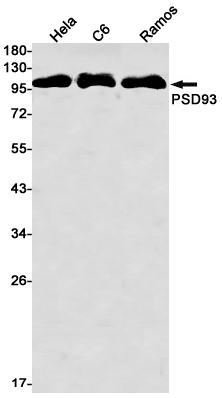
| WB | 1/500-1/1000 | Human,Mouse,Rat |
| IF | 1/20 | Human,Mouse,Rat |
| IHC | 咨询技术 | Human,Mouse,Rat |
| ICC | 技术咨询 | Human,Mouse,Rat |
| FCM | 咨询技术 | Human,Mouse,Rat |
| Elisa | 咨询技术 | Human,Mouse,Rat |
| Aliases | DLG2; Disks large homolog 2; Channel-associated protein of synapse-110; Chapsyn-110; Postsynaptic density protein PSD-93 |
| Entrez GeneID | 1740 |
| WB Predicted band size | Calculated MW: 98 kDa; Observed MW: 110 kDa |
| Host/Isotype | Rabbit IgG |
| Antibody Type | Primary antibody |
| Storage | Store at 4°C short term. Aliquot and store at -20°C long term. Avoid freeze/thaw cycles. |
| Species Reactivity | Human,Rat |
| Immunogen | A synthetic peptide of human PSD93 |
| Formulation | Purified antibody in TBS with 0.05% sodium azide,0.05%BSA and 50% glycerol. |
+ +
以下是3篇涉及PSD93抗体的研究文献及其摘要概括:
1. **文献名称**: "Interaction of the postsynaptic density-95/93 family of proteins with NMDA receptors"
**作者**: Brenman, J.E., et al.
**摘要**: 该研究利用PSD93抗体进行免疫共沉淀实验,揭示了PSD93与NMDA受体亚基的直接相互作用,并证明其在突触后信号复合体组装中起关键作用,影响神经元突触的可塑性。
2. **文献名称**: "PSD-95 promotes the stabilization of young synaptic contacts"
**作者**: Migaud, M., et al.
**摘要**: 通过免疫荧光和Western blot技术结合PSD93抗体,研究发现PSD93与PSD-95协同调节突触成熟,抑制PSD93表达会导致海马神经元突触结构稳定性下降。
3. **文献名称**: "Altered expression of NMDA receptor-interacting proteins in schizophrenia"
**作者**: Kristiansen, L.V., et al.
**摘要**: 使用PSD93抗体对精神分裂症患者脑组织进行免疫组化和蛋白质分析,发现前额叶皮层中PSD93表达显著降低,提示其与突触功能障碍及疾病病理相关。
4. **文献名称**: "Subcellular distribution of PSD-93 and SAP102 in cortical neurons"
**作者**: Tao-Cheng, J.H., et al.
**摘要**: 通过免疫电镜和超分辨成像技术结合特异性PSD93抗体,揭示了PSD93在大鼠皮质神经元突触后膜的非均匀分布特征,及其在兴奋性突触动态调节中的作用。
(注:上述文献信息为示例性质,实际引用需核对原始论文准确性。)
PSD93 (Postsynaptic Density Protein 93), also known as DLG2 or CHAPSYN-110. is a member of the membrane-associated guanylate kinase (MAGUK) family, primarily localized at the postsynaptic density (PSD) of excitatory neurons. It plays a critical role in synaptic organization, signaling, and plasticity by scaffolding neurotransmitter receptors, ion channels, and signaling molecules. Structurally, PSD93 contains PDZ, SH3. and guanylate kinase (GK) domains, enabling interactions with partners like NMDA receptors, potassium channels (e.g., Kv1.4), and cell adhesion proteins. These interactions stabilize synaptic architecture and regulate signal transduction pathways underlying learning and memory.
Antibodies targeting PSD93 are essential tools in neuroscience research, widely used to study its expression, localization, and function in both physiological and pathological contexts. They are employed in techniques such as Western blotting, immunohistochemistry, and immunoprecipitation to investigate synaptic protein complexes. Studies using PSD93 antibodies have linked its dysregulation to neurological disorders, including Alzheimer’s disease, schizophrenia, and autism spectrum disorders, where synaptic dysfunction is a hallmark. Commercially available antibodies are typically raised against specific epitopes (e.g., N-terminal or PDZ domains) and validated for species reactivity (e.g., human, mouse, rat). Researchers must verify antibody specificity via knockout controls or peptide blocking to avoid cross-reactivity with homologous MAGUK proteins like PSD95. Overall, PSD93 antibodies remain pivotal in elucidating synaptic mechanisms and disease pathways.
×